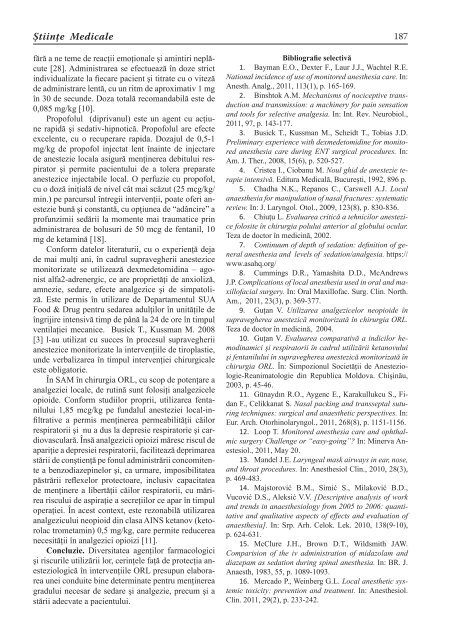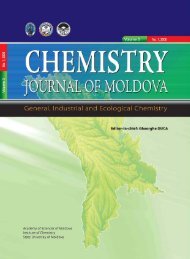stiinte med 3 2011.indd - Academia de ÅtiinÅ£e a Moldovei
stiinte med 3 2011.indd - Academia de ÅtiinÅ£e a Moldovei
stiinte med 3 2011.indd - Academia de ÅtiinÅ£e a Moldovei
You also want an ePaper? Increase the reach of your titles
YUMPU automatically turns print PDFs into web optimized ePapers that Google loves.
Ştiinţe Medicale<br />
fără a ne teme <strong>de</strong> reacţii emoţionale şi amintiri neplăcute<br />
[28]. Administrarea se efectuează în doze strict<br />
individualizate la fiecare pacient şi titrate cu o viteză<br />
<strong>de</strong> administrare lentă, cu un ritm <strong>de</strong> aproximativ 1 mg<br />
în 30 <strong>de</strong> secun<strong>de</strong>. Doza totală recomandabilă este <strong>de</strong><br />
0,085 mg/kg [10].<br />
Propofolul (diprivanul) este un agent cu acţiune<br />
rapidă şi sedativ-hipnotică. Propofolul are efecte<br />
excelente, cu o recuperare rapida. Dozajul <strong>de</strong> 0,5-1<br />
mg/kg <strong>de</strong> propofol injectat lent înainte <strong>de</strong> injectare<br />
<strong>de</strong> anestezie locala asigură menţinerea <strong>de</strong>bitului respirator<br />
şi permite pacientului <strong>de</strong> a tolera preparate<br />
anestezice injectabile local. O perfuzie cu propofol,<br />
cu o doză iniţială <strong>de</strong> nivel cât mai scăzut (25 mcg/kg/<br />
min.) pe parcursul întregii intervenţii, poate oferi anestezie<br />
bună şi constantă, cu opţiunea <strong>de</strong> “adâncire” a<br />
profunzimii sedării la momente mai traumatice prin<br />
administrarea <strong>de</strong> bolusuri <strong>de</strong> 50 mcg <strong>de</strong> fentanil, 10<br />
mg <strong>de</strong> ketamină [18].<br />
Conform datelor literaturii, cu o experienţă <strong>de</strong>ja<br />
<strong>de</strong> mai mulţi ani, în cadrul supravegherii anestezice<br />
monitorizate se utilizează <strong>de</strong>x<strong>med</strong>etomidina – agonist<br />
alfa2-adrenergic, ce are proprietăţi <strong>de</strong> anxioliză,<br />
amnezie, sedare, efecte analgezice şi <strong>de</strong> simpatoliză.<br />
Este permis în utilizare <strong>de</strong> Departamentul SUA<br />
Food & Drug pentru sedarea adulţilor în unităţile <strong>de</strong><br />
îngrijire intensivă timp <strong>de</strong> până la 24 <strong>de</strong> ore în timpul<br />
ventilaţiei mecanice. Busick T., Kussman M. 2008<br />
[3] l-au utilizat cu succes în procesul supravegherii<br />
anestezice monitorizate la intervenţiile <strong>de</strong> tiroplastie,<br />
un<strong>de</strong> verbalizarea în timpul intervenţiei chirurgicale<br />
este obligatorie.<br />
În SAM în chirurgia ORL, cu scop <strong>de</strong> potenţare a<br />
analgeziei locale, <strong>de</strong> rutină sunt folosiţi analgezicele<br />
opioi<strong>de</strong>. Conform studiilor proprii, utilizarea fentanilului<br />
1,85 mcg/kg pe fundalul anesteziei local-infiltrative<br />
a permis menţinerea permeabilităţii căilor<br />
respiratorii şi nu a dus la <strong>de</strong>presie respiratorie şi cardiovasculară.<br />
Însă analgezicii opioizi măresc riscul <strong>de</strong><br />
apariţie a <strong>de</strong>presiei respiratorii, facilitează <strong>de</strong>primarea<br />
stării <strong>de</strong> conştienţă pe fonul administrării concomitente<br />
a benzodiazepinelor şi, ca urmare, imposibilitatea<br />
păstrării reflexelor protectoare, inclusiv capacitatea<br />
<strong>de</strong> menţinere a libertăţii căilor respiratorii, cu mărirea<br />
riscului <strong>de</strong> aspiraţie a secreţiilor ce apar în timpul<br />
operaţiei. În acest context, este rezonabilă utilizarea<br />
analgezicului neopioid din clasa AINS ketanov (ketorolac<br />
trometamin) 0,5 mg/kg, care permite reducerea<br />
necesităţii în analgezici opioizi [11].<br />
Concluzie. Diversitatea agenţilor farmacologici<br />
şi riscurile utilizării lor, cerinţele faţă <strong>de</strong> protecţia anesteziologică<br />
în intervenţiile ORL presupun elaborarea<br />
unei conduite bine <strong>de</strong>terminate pentru menţinerea<br />
gradului necesar <strong>de</strong> sedare şi analgezie, precum şi a<br />
stării a<strong>de</strong>cvate a pacientului.<br />
187<br />
Bibliografie selectivă<br />
1. Bayman E.O., Dexter F., Laur J.J., Wachtel R.E.<br />
National inci<strong>de</strong>nce of use of monitored anesthesia care. In:<br />
Anesth. Analg., 2011, 113(1), p. 165-169.<br />
2. Binshtok A.M. Mechanisms of nociceptive transduction<br />
and transmission: a machinery for pain sensation<br />
and tools for selective analgesia. In: Int. Rev. Neurobiol.,<br />
2011, 97, p. 143-177.<br />
3. Busick T., Kussman M., Scheidt T., Tobias J.D.<br />
Preliminary experience with <strong>de</strong>x<strong>med</strong>etomidine for monitored<br />
anesthesia care during ENT surgical procedures. In:<br />
Am. J. Ther., 2008, 15(6), p. 520-527.<br />
4. Cristea I., Ciobanu M. Noul ghid <strong>de</strong> anestezie terapie<br />
intensivă. Editura Medicală, Bucureşti, 1992, 896 p.<br />
5. Chadha N.K., Repanos C., Carswell A.J. Local<br />
anaesthesia for manipulation of nasal fractures: systematic<br />
review. In: J. Laryngol. Otol., 2009, 123(8), p. 830-836.<br />
6. Chiuţu L. Evaluarea critică a tehnicilor anestezice<br />
folosite în chirurgia polului anterior al globului ocular.<br />
Teza <strong>de</strong> doctor în <strong>med</strong>icină, 2002.<br />
7. Continuum of <strong>de</strong>pth of sedation: <strong>de</strong>fi nition of general<br />
anesthesia and levels of sedation/analgesia. https://<br />
www.asahq.org/<br />
8. Cummings D.R., Yamashita D.D., McAndrews<br />
J.P. Complications of local anesthesia used in oral and maxillofacial<br />
surgery. In: Oral Maxillofac. Surg. Clin. North.<br />
Am., 2011, 23(3), p. 369-377.<br />
9. Guţan V. Utilizarea analgezicelor neopioi<strong>de</strong> în<br />
supravegherea anestezică monitorizată în chirurgia ORL.<br />
Teza <strong>de</strong> doctor în <strong>med</strong>icină, 2004.<br />
10. Guţan V. Evaluarea comparativă a indicilor hemodinamici<br />
şi respiratorii în cadrul utilizării ketanovului<br />
şi fentanilului în supravegherea anestezică monitorizată în<br />
chirurgia ORL. În: Simpozionul Societăţii <strong>de</strong> Anesteziologie-Reanimatologie<br />
din Republica Moldova. Chişinău,<br />
2003, p. 45-46.<br />
11. Günaydın R.O., Aygenc E., Karakullukcu S., Fidan<br />
F., Celikkanat S. Nasal packing and transseptal suturing<br />
techniques: surgical and anaesthetic perspectives. In:<br />
Eur. Arch. Otorhinolaryngol., 2011, 268(8), p. 1151-1156.<br />
12. Loop T. Monitored anesthesia care and ophthalmic<br />
surgery Challenge or “easy-going”? In: Minerva Anestesiol.,<br />
2011, May 20.<br />
13. Man<strong>de</strong>l J.E. Laryngeal mask airways in ear, nose,<br />
and throat procedures. In: Anesthesiol Clin., 2010, 28(3),<br />
p. 469-483.<br />
14. Majstorović B.M., Simić S., Milaković B.D.,<br />
Vucović D.S., Aleksić V.V. [Descriptive analysis of work<br />
and trends in anaesthesiology from 2005 to 2006: quantitative<br />
and qualitative aspects of effects and evaluation of<br />
anaesthesia]. In: Srp. Arh. Celok. Lek. 2010, 138(9-10),<br />
p. 624-631.<br />
15. McClure J.H., Brown D.T., Wildsmith JAW.<br />
Comparision of the iv administration of midazolam and<br />
diazepam as sedation during spinal anesthesia. In: BR. J.<br />
Anaesth, 1983, 55, p. 1089-1093.<br />
16. Mercado P., Weinberg G.L. Local anesthetic systemic<br />
toxicity: prevention and treatment. In: Anesthesiol.<br />
Clin. 2011, 29(2), p. 233-242.

















